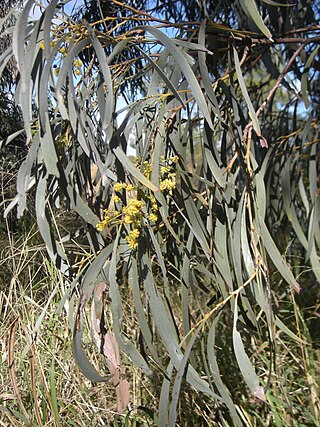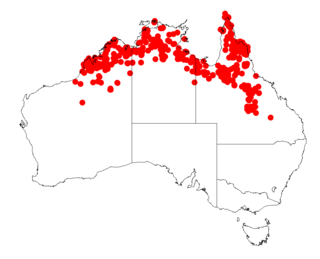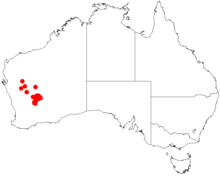
Acacia aneura, commonly known as mulga or true mulga, is a shrub or small tree native to arid outback areas of Australia. It is the dominant tree in the habitat to which it gives its name (mulga) that occurs across much of inland Australia. Specific regions have been designated the Western Australian mulga shrublands in Western Australia and Mulga Lands in Queensland.

The Carnarvon xeric shrublands is a deserts and xeric shrublands ecoregion of Western Australia. The ecoregion is coterminous with the Carnarvon Interim Biogeographic Regionalisation for Australia (IBRA) bioregion.

Acacia pycnantha, most commonly known as the golden wattle, is a tree of the family Fabaceae native to southeastern Australia. It grows to a height of 8 m (26 ft) and has phyllodes instead of true leaves. Sickle-shaped, these are between 9 and 15 cm long, and 1–3.5 cm wide. The profuse fragrant, golden flowers appear in late winter and spring, followed by long seed pods. Plants are cross-pollinated by several species of honeyeater and thornbill, which visit nectaries on the phyllodes and brush against flowers, transferring pollen between them. An understorey plant in eucalyptus forest, it is found from southern New South Wales and the Australian Capital Territory, through Victoria and into southeastern South Australia.

Rosewood is any of a number of richly hued hardwoods, often brownish with darker veining, but found in other colours. It is hard, tough, strong, and dense. True rosewoods come from trees of the genus Dalbergia, but other woods are often called rosewood. Rosewood takes a high polish and is used for luxury furniture-making, flooring, musical instruments, and turnery.

Acacia cyclops, commonly known as coastal wattle, cyclops wattle, one-eyed wattle, red-eyed wattle, redwreath acacia, western coastal wattle, rooikrans, rooikrans acacia, is a coastal shrub or small tree in the family Fabaceae. Native to Australia, it is distributed along the west coast of Western Australia as far north as Leeman, and along the south coast into South Australia. The Noongar peoples of Western Australia know the plant as wilyawa or woolya wah.

Acacia saligna, commonly known by various names including coojong, golden wreath wattle, orange wattle, blue-leafed wattle, Western Australian golden wattle, and, in Africa, Port Jackson willow, is a small tree in the family Fabaceae. Native to Australia, it is widely distributed throughout the south west corner of Western Australia, extending north as far as the Murchison River, and east to Israelite Bay. The Noongar peoples know the tree as Cujong.

Acacia cuspidifolia, commonly known as wait-a-while or bohemia, is a tree in the family Fabaceae. Endemic to Western Australia, it occurs on the floodplains east of Carnarvon.

Acacia quadrimarginea, commonly known as granite wattle or spreading wattle, is a tree in the family Mimosaceae. Endemic to Western Australia, it occurs through arid south-central Western Australia. It is common on granite, but also occurs on sand and clay, and is often seen along creeklines in rocky hills.

Acacia, commonly known as the wattles or acacias, is a genus of about 1084 species of shrubs and trees in the subfamily Mimosoideae of the pea family Fabaceae. Initially, it comprised a group of plant species native to Africa, South America and Australasia, but is now reserved for species mainly from Australia, with others from New Guinea, Southeast Asia and the Indian Ocean. The genus name is Neo-Latin, borrowed from the Greek ἀκακία, a term used by Dioscorides for a preparation extracted from the leaves and fruit pods of Vachellia nilotica, the original type of the genus. In his Pinax (1623), Gaspard Bauhin mentioned the Greek ἀκακία from Dioscorides as the origin of the Latin name.

Acacia melanoxylon, commonly known as the Australian blackwood, is an Acacia species native in South eastern Australia. The species is also known as blackwood, hickory, mudgerabah, Tasmanian blackwood, or blackwood acacia. The tree belongs to the Plurinerves section of Acacia and is one of the most wide-ranging tree species in eastern Australia and is quite variable mostly in the size and shape of the phyllodes.

Acacia harpophylla, commonly known as brigalow, brigalow spearwood or orkor, is an endemic tree of Australia. The Aboriginal Australian group the Gamilaraay peoples know the tree as Barranbaa or Burrii. It is found in central and coastal Queensland to northern New South Wales. It can reach up to 25 m (82 ft) tall and forms extensive open-forest communities on clay soils.

Vachellia nilotica, more commonly known as Acacia nilotica, and by the vernacular names of gum arabic tree, babul, thorn mimosa, Egyptian acacia or thorny acacia, is a flowering tree in the family Fabaceae. It is native to Africa, the Middle East and the Indian subcontinent. It is also considered a 'weed of national significance' and an invasive species of concern in Australia, as well as a noxious weed by the federal government of the United States.

Acacia beauverdiana, commonly known as pukkati, is a member of genus Acacia that is native to Western Australia. It is a perennial tree 1 to 8 metres tall with multiple stems. It has yellow flowers and it blooms from July to October. It is native to Western Australia.

Acacia delibrata is a perennial shrub or tree growing to 9m in height, with a distinctive "minni ritchi" bark, flowering from April to June and in October. It is native to tropical Western Australia. It is not listed as being a threatened species. A crude saponin solution in water, prepared from the seed pods of a tree believed to be this species, was found to be severely irritant when applied to the eyes of a dog.

Acacia stenophylla is a species of Acacia commonly referred to as the shoestring acacia. It is an evergreen tree in the family Fabaceae native to Australia. It is not considered rare or endangered.

Acacia didyma is a shrub or small tree which is native to Western Australia. It grows to between 1.5 metres and 4 metres in height and flowers from August to October in its native range.

Acacia euthycarpa is a shrub or small tree species that is endemic to southern Australia. It shares its common names of wallowa or reed-leaf wattle with a similar species Acacia calamifolia. It usually grows as a shrub to between 2 and 4 metres high, but certain forms may be small trees up to 10 metres high. The linear phyllodes are up to 10 cm long, dull green or grey green and have sharply pointed hooked tips. The globular golden flowerheads appear in 2-4 headed racemes between August and October, followed by curved seedpods that are up to 15 cm long.

Acacia platycarpa, commonly known as the pindan wattle or ghost wattle, is a species of plant in the legume family that is native to northern Australia from Western Australia through the Northern Territory to Queensland.
Hibbertia cockertoniana is a species of flowering plant in the family Dilleniaceae and is endemic to the south-west of Western Australia. It is an erect shrub with scattered linear leaves and yellow flowers arranged singly in leaf axils usually with ten stamens all on one side of the two carpels.


















